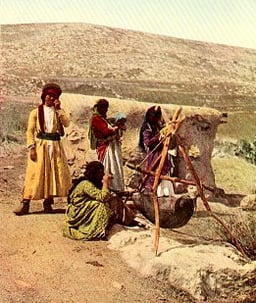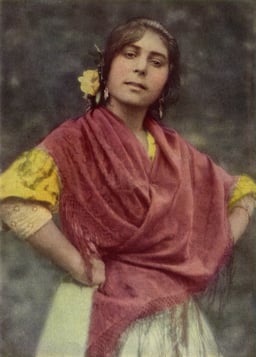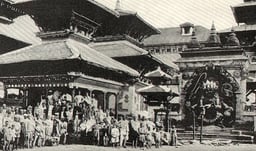National Geographic (magazine)

National Geographic (magazine)

 March 2017 cover of National Geographic | |
| Editor | Susan Goldberg[1] |
|---|---|
| Categories | Geography, Science, History, Nature Cultures |
| Frequency | Monthly |
| Total circulation (June 2016) | 6.1 million (Global)[2] |
| First issue | September 22, 1888 (1888-09-22)[3] |
| Company | National Geographic Partners (The Walt Disney Company [73%] National Geographic Society [27%])[4] |
| Country | United States |
| Based in | Washington, D.C.[5] |
| Language | English and various other languages |
| Website | ngm.nationalgeographic.com [32] |
| ISSN | 0027-9358 [33] |
| OCLC | 643483454 [34] |
National Geographic (formerly the National Geographic Magazine and branded also as NAT GEO) is the official magazine of the National Geographic Society. It has been published continuously since its first issue in 1888, nine months after the Society itself was founded. It primarily contains articles about science, geography, history, and world culture. The magazine is known for its thick square-bound glossy format with a yellow rectangular border and its extensive use of dramatic photographs. Controlling interest in the magazine has been held by The Walt Disney Company since 2019.
The magazine is published monthly, and additional map supplements are also included with subscriptions. It is available in a traditional printed edition and through an interactive online edition. On occasion, special editions of the magazine are issued.
As of 2015, the magazine was circulated worldwide in nearly 40 local-language editions and had a global circulation of approximately 6.5 million per month according to data published by The Washington Post (down from about 12 million in the late 1980s) or 6.7 million according to National Geographic. This includes a US circulation of 3.5 million.[6][7]
 March 2017 cover of National Geographic | |
| Editor | Susan Goldberg[1] |
|---|---|
| Categories | Geography, Science, History, Nature Cultures |
| Frequency | Monthly |
| Total circulation (June 2016) | 6.1 million (Global)[2] |
| First issue | September 22, 1888 (1888-09-22)[3] |
| Company | National Geographic Partners (The Walt Disney Company [73%] National Geographic Society [27%])[4] |
| Country | United States |
| Based in | Washington, D.C.[5] |
| Language | English and various other languages |
| Website | ngm.nationalgeographic.com [32] |
| ISSN | 0027-9358 [33] |
| OCLC | 643483454 [34] |
Administration
The current Editor-in-Chief of the National Geographic Magazine is Susan Goldberg.[1] Goldberg is also Editorial Director for National Geographic Partners, overseeing the print and digital expression of National Geographic’s editorial content across its media platforms including National Geographic magazine. She is responsible for news, National Geographic Traveler magazine, National Geographic History magazine, maps, and all editorial digital content with the exception of National Geographic Books and Kids. Goldberg reports to Gary Knell, CEO of National Geographic Partners.
History
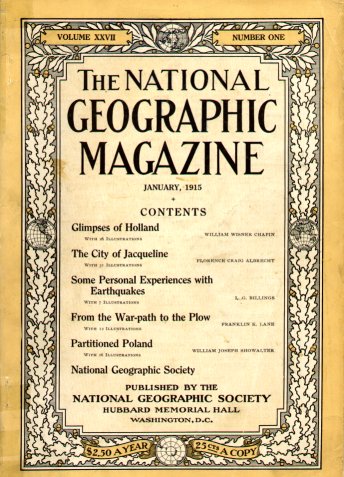
January 1915 cover of The National Geographic Magazine
The first issue of National Geographic Magazine was published on September 22, 1888, nine months after the Society was founded. It was initially a scholarly journal sent to 165 charter members and nowadays it reaches the hands of 40 million people each month.[8] Starting with its January 1905 publication of several full-page pictures of Tibet in 1900–1901, the magazine changed from being a text-oriented publication closer to a scientific journal to featuring extensive pictorial content, and became well known for this style. The June 1985 cover portrait of the presumed to be 12-year-old Afghan girl Sharbat Gula, shot by photographer Steve McCurry, became one of the magazine's most recognizable images.
National Geographic Kids, the children's version of the magazine, was launched in 1975 under the name National Geographic World. From the 1970s through about 2010 the magazine was printed in Corinth, Mississippi, by private printers until that plant was finally closed.
In the late 1990s, the magazine began publishing The Complete National Geographic, a digital compilation of all the past issues of the magazine. It was then sued over copyright of the magazine as a collective work in Greenberg v. National Geographic and other cases, and temporarily withdrew the availability of the compilation. The magazine eventually prevailed in the dispute, and in July 2009 it resumed publishing a compilation containing all issues through December 2008. The compilation was later updated to make more recent issues available, and the archive and digital edition of the magazine are available online to the magazine's subscribers.
In September 2015, the National Geographic Society moved the magazine to a new partnership, National Geographic Partners, in which 21st Century Fox hed a 73 percent controlling interest.[9]
Editors-in-chief
The magazine had a single "editor" from 1888–1920. From 1920–1967, the chief editorship was held by the president of the National Geographic Society. Since 1967, the magazine has been overseen by its own "editor-in-chief". The list of editors-in-chief includes three generations of the Grosvenor family between 1903 and 1980.
John Hyde (October 1888 – 14 September 1900; Editor-in-Chief: 14 September 1900 – February 1903)
Gilbert Hovey Grosvenor (1875–1966) (Editor-in-Chief: February 1903 – 20 January 1920; Managing Editor: 14 September 1900 – February 1903; Assistant Editor: May 1899 – 14 September 1900)
Gilbert Hovey Grosvenor (21 January 1920 – 5 May 1954)
John Oliver LaGorce (1880–1959) (5 May 1954 – 8 January 1957)
Melville Bell Grosvenor (1901–1982) (8 January 1957 – 1 August 1967)
Frederick Vosburgh (1905–2005) (1 August 1967 – October 1970)
Gilbert Melville Grosvenor (1931– ) (October 1970 – July 1980)
Wilbur E. Garrett (July 1980 – April 1990)
William Graves (April 1990 – December 1994)
William L. Allen (January 1995 – January 2005)
Chris Johns (January 2005 – April 2014)
Articles
During the Cold War, the magazine committed itself to presenting a balanced view of the physical and human geography of nations beyond the Iron Curtain. The magazine printed articles on Berlin, de-occupied Austria, the Soviet Union, and Communist China that deliberately downplayed politics to focus on culture. In its coverage of the Space Race, National Geographic focused on the scientific achievement while largely avoiding reference to the race's connection to nuclear arms buildup. There were also many articles in the 1930s, 40s and 50s about the individual states and their resources, along with supplement maps of each state. Many of these articles were written by longtime staff such as Frederick Simpich.[13] There were also articles about biology and science topics.
In later years, articles became outspoken on issues such as environmental issues, deforestation, chemical pollution, global warming, and endangered species. Series of articles were included focusing on the history and varied uses of specific products such as a single metal, gem, food crop, or agricultural product, or an archaeological discovery. Occasionally an entire month's issue would be devoted to a single country, past civilization, a natural resource whose future is endangered, or other theme. In recent decades, the National Geographic Society has unveiled other magazines with different focuses. Whereas in the past, the magazine featured lengthy expositions, recent issues have shorter articles.
Photography
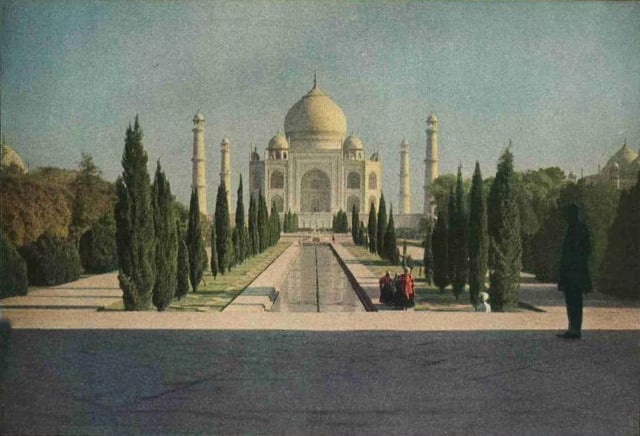
Color photograph of the Taj Mahal. Source: The National Geographic Magazine, March 1921
In addition to being well known for articles about scenery, history, and the most distant corners of the world, the magazine has been recognized for its book-like quality and its standard of photography. It was during the tenure of Society President Alexander Graham Bell and editor Gilbert H. Grosvenor (GHG) that the significance of illustration was first emphasized, in spite of criticism from some of the Board of Managers who considered the many illustrations an indicator of an “unscientific” conception of geography. By 1910, photographs had become the magazine’s trademark and Grosvenor was constantly on the search for "dynamical pictures" as Graham Bell called them, particularly those that provided a sense of motion in a still image. In 1915, GHG began building the group of staff photographers and providing them with advanced tools including the latest darkroom.[14]
The magazine began to feature some pages of color photography in the early 1930s, when this technology was still in its early development. During the mid-1930s, Luis Marden (1913–2003), a writer and photographer for National Geographic, convinced the magazine to allow its photographers to use the so-called "miniature" 35 mm Leica cameras loaded with Kodachrome film over bulkier cameras with heavy glass plates that required the use of tripods.[15] In 1959, the magazine started publishing small photographs on its covers, later becoming larger photographs. National Geographic photography quickly shifted to digital photography for both its printed magazine and its website. In subsequent years, the cover, while keeping its yellow border, shed its oak leaf trim and bare table of contents, to allow for a full page photograph taken for one of the month's articles. Issues of National Geographic are often kept by subscribers for years and re-sold at thrift stores as collectibles. The standard for photography has remained high over the subsequent decades and the magazine is still illustrated with some of the highest-quality photojournalism in the world.[16] In 2006, National Geographic began an international photography competition, with over eighteen countries participating.[17]
In conservative Muslim countries like Iran and Malaysia, photographs featuring topless or scantily clad members of primitive tribal societies are often blacked out; buyers and subscribers often complain that this practice decreases the artistic value of the photographs for which National Geographic is world-renowned.
Gallery
Map supplements
Supplementing the articles, the magazine sometimes provides maps of the regions visited.
National Geographic Maps (originally the Cartographic Division) became a division of the National Geographic Society in 1915. The first supplement map, which appeared in the May 1918 issue of the magazine, titled The Western Theatre of War, served as a reference for overseas military personnel and soldiers' families alike.[18] On some occasions, the Society's map archives have been used by the United States government in instances where its own cartographic resources were limited.[19] President Franklin D. Roosevelt's White House map room was filled with National Geographic maps. A National Geographic map of Europe is featured in the displays of the Winston Churchill museum in London showing Churchill's markings at the Yalta Conference where the Allied leaders divided post-war Europe.
In 2001, National Geographic released an eight-CD-ROM set containing all its maps from 1888 to December 2000. Printed versions are also available from the National Geographic website.[20]
Language editions

First Ukrainian National Geographic magazine presentation

National Geographic English editions collection
On 1995, National Geographic began publishing in Japanese, its first local language edition. The magazine is currently published in 37 local editions around the world.
| Language | Website | Editor-in-chief | First issue |
|---|---|---|---|
| English (United States) | ngm.com [35] | Susan Goldberg | October 1888 |
| Farsi (Iran) | www.ngmfarsi.com [36] | Babak Nikkhah Bahrami | October 2012 |
| Arabic (United Arab Emirates) | ngalarabiya.com [37] | Alsaad Omar Almenhaly | October 2010 |
| Bulgarian | nationalgeographic.bg [38] | Krassimir Drumev | November 2005 |
| Chinese (China) | nationalgeographic.com.cn [39] | Bin Wang | July 2007 |
| Chinese (Taiwan) | ngtaiwan.com [40] | Yungshih Lee | January 2001 |
| Croatian | nationalgeographic.com.hr [41] | Hrvoje Prćić | November 2003 |
| Czech | national-geographic.cz [42] | Kateřina Fejková | October 2002 |
| Danish | natgeo.dk [43] | Karen Gunn | September 2000 |
| Dutch (Netherlands/Belgium) | nationalgeographic.nl [44] | Aart Aarsbergen | October 2000 |
| English (India) | getnationalgeographic.com [45] | Niloufer Venkatraman | |
| Estonian | national-geographic.ee [46] | Erkki Peetsalu | October 2011 |
| Finnish | natgeo.fi [47] | Karen Gunn | January 2001 |
| French | nationalgeographic.fr [48] | Jean-Pierre Vrignaud | October 1999 |
| Georgian | nationalgeographic.ge [49] | Natia Khuluzauri | October 2012 |
| German | nationalgeographic.de [50] | Florian Gless | October 1999 |
| Hungarian | ng.hu [51] | Tamás Vitray | March 2003 |
| Hebrew | nationalgeographic.co.il [52] | Daphne Raz | June 1998 |
| Hebrew (Orthodox) | April 2007 | ||
| Indonesian | nationalgeographic.co.id [53] | Didi Kaspi Kasim | April 2005 |
| Italian | nationalgeographic.it [54] | Marco Cattaneo | February 1998 |
| Japanese | nationalgeographic.jp [55] | Shigeo Otsuka | April 1995 |
| Kazakh | nationalgeographic.kz [56] | Yerkin Zhakipov | February 2016 |
| Korean (South Korea) | nationalgeographic.co.kr [57] | Junemo Kim | January 2000 |
| Lithuanian | nationalgeographic.lt [58] | Frederikas Jansonas | October 2009 |
| Norwegian | natgeo.no [59] | Karen Gunn | September 2000 |
| Polish | nationalgeographic.pl [60] | Agnieszka Franus | October 1999 |
| Portuguese (Brazil) | ngbrasil.com.br [61] | Ronaldo Ribeiro | May 2000 |
| Portuguese (Portugal) | nationalgeographic.pt [62] | Gonçalo Pereira | April 2001 |
| Romanian | natgeo.ro [63] | Cătălin Gruia | May 2003 |
| Russian | nat-geo.ru [64] | Alexander Grek | October 2003 |
| Serbian | nationalgeographic.rs [65] | Igor Rill | November 2006 |
| Slovene | nationalgeographic.si [66] | Marija Javornik | April 2006 |
| Spanish (Latin America) | ngenespanol.com [67] | Claudia Muzzi Turullols | November 1997 |
| Spanish (Spain) | nationalgeographic.com.es [68] | Josep Cabello | October 1997 |
| Swedish | natgeo.se [69] | Karen Gunn | September 2000 |
| Thai | ngthai.com [70] | Kowit Phadungruangkij | August 2001 |
| Turkish | nationalgeographic.com.tr [71] | Nesibe Bat | May 2001 |
The following local-language editions have been discontinued:
| Language | Website | First issue | Last issue | Number of issues |
|---|---|---|---|---|
| Mongolian | nationalgeographic.mn [72] | October 2012 | June 2014 | 21 |
| Greek | nationalgeographic.gr [73] | October 1998 | December 2014 | 194 |
| Ukrainian | April 2013 | January 2015 | 21 | |
| Azerbaijani | nationalgeographic.az [74] | September 2014 | December 2015 | 16 |
| Latvian | nationalgeographic.lv [75] | October 2012 | March 2016 | 42 |
In association with Trends Publications in Beijing and IDG Asia, National Geographic has been authorized for "copyright cooperation" in China to publish the yellow border magazine, which launched with the July 2007 issue of the magazine with an event in Beijing on July 10, 2007 and another event on December 6, 2007 in Beijing also celebrating the 29th anniversary of normalization of U.S.–China relations featuring former President Jimmy Carter. The mainland China version is one of the two local-language editions that bump the National Geographic logo off its header in favor of a local-language logo; the other one is the Persian version published under the name Gita Nama.
Worldwide editions are sold on newsstands in addition to regular subscriptions. In several countries, such as Hungary, Slovenia, Croatia, Turkey and Ukraine National Geographic paved the way for a subscription model in addition to traditional newsstand sales.In the United States, newsstand sales began in 1998; previously, membership in the National Geographic Society was the only way to receive the magazine,
Awards
On May 1, 2008, National Geographic won three National Magazine Awards—an award solely for its written content—in the reporting category for an article by Peter Hessler on the Chinese economy; an award in the photojournalism category for work by John Stanmeyer on malaria in the Third World; and a prestigious award for general excellence.[21]
Between 1980 and 2011 the magazine has won a total of 24 National Magazine Awards.[22]
In May 2006, 2007, and 2011 National Geographic magazine won the American Society of Magazine Editors' General Excellence Award in the over two million circulation category. In 2010, National Geographic Magazine received the top ASME awards for photojournalism and essay. In 2011, National Geographic Magazine received the top-award from ASME—the Magazine of the Year Award.
In April 2014, National Geographic received the National Magazine Award ("Ellie") for best tablet edition for its multimedia presentation of Robert Draper's story "The Last Chase," about the final days of a tornado researcher who was killed in the line of duty.[23]
In February 2017, National Geographic received the National Magazine Award ("Ellie") for best website.[24]
Controversies
On the magazine's February 1982 cover, the pyramids of Giza were altered, resulting in the first major scandal of the digital photography age and contributing to photography's "waning credibility".[25]
The cover of the October 1988 issue featured a photo of a large ivory male portrait whose authenticity, particularly the alleged Ice Age provenance, has been questioned.[26]
In 1999, the magazine was embroiled in the Archaeoraptor scandal, in which it purported to have a fossil linking birds to dinosaurs. The fossil was a forgery.
In 2010, the magazine's Your Shot competition was awarded to William Lascelles for photography featuring a dog with fighter jets over its shoulder. The picture turned out to be a fraud.[27]
See also
Asian Geographic
Australian Geographic
Canadian Geographic and Géographica in Canada
Chinese National Geography (founded in 1949)
Chris Johns (photographer), staff photographer and subsequently, editor-in-chief (2005–2014) of the magazine
GEO, Germany
Joel Sartore staff photographer, head of The Photo Ark project
John Patric, noted writer for National Geographic during the 1930s and 1940s
National Geographic Kids
National Geographic Traveler
The Photo Ark
Royal Geographical Society
Vokrug sveta (Russian: Around the World)


